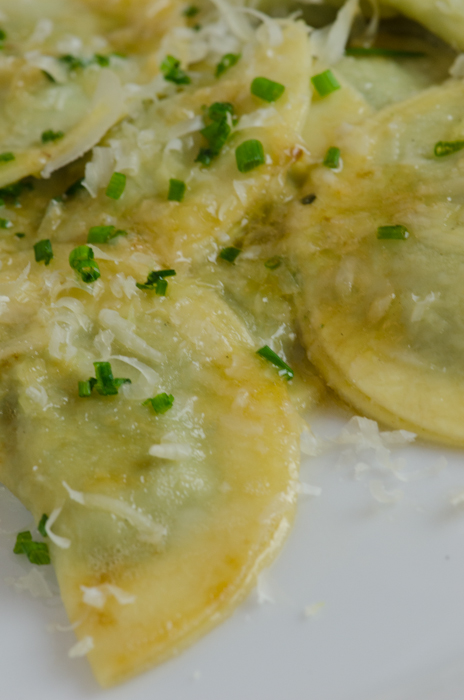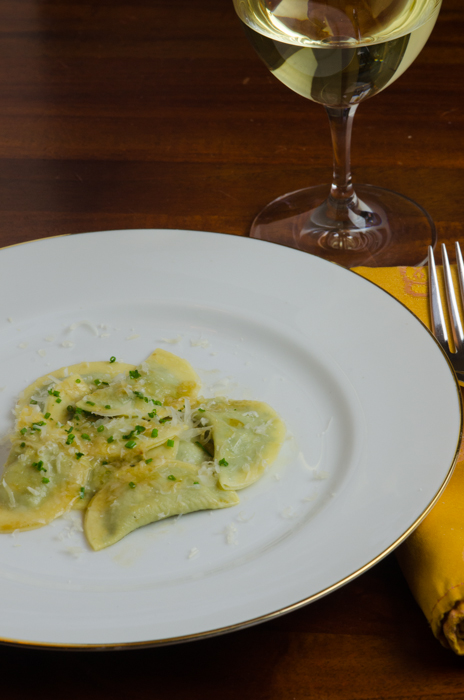 During many of our walking tours or cycling adventures, when we visit a small local restaurant catering to non-tourists, I am called upon to translate the menu. This is a particular challenge in Alto Adige, where the menu is just as likely to be in German as Italian. One wonderful traditional dish of the region, with a name that can evoke a chuckle from guests, is Schlutzkrapfen.
During many of our walking tours or cycling adventures, when we visit a small local restaurant catering to non-tourists, I am called upon to translate the menu. This is a particular challenge in Alto Adige, where the menu is just as likely to be in German as Italian. One wonderful traditional dish of the region, with a name that can evoke a chuckle from guests, is Schlutzkrapfen.
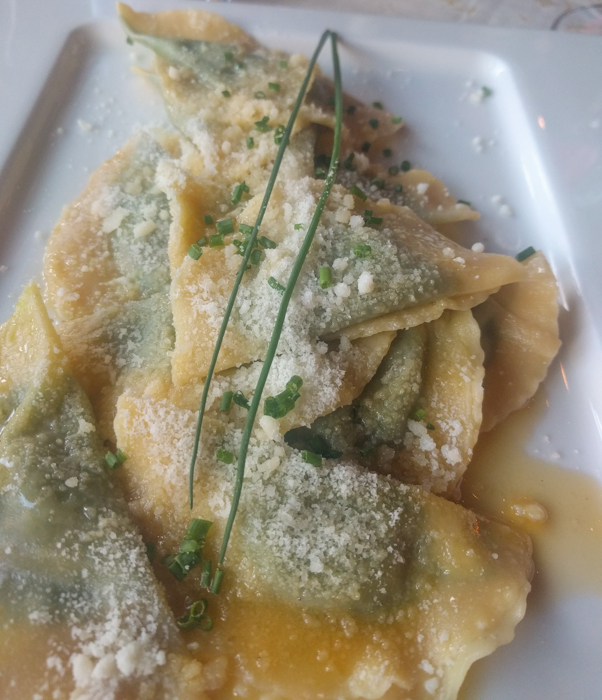 Schlutzkrapfen, called Mezzelune (“half moons”) by the Italian speaking natives of the region, are semi-circular stuffed pasta, similar to ravioli.They are also known as Ravioli della Pusteria, after the Pusteria valley. The dough is usually made of white flour, sometimes mixed with rye or buckwheat flour, mixed with eggs and milk. The fillings may vary, but the most typical is ricotta cheese and spinach. These would often be served during days of abstinence, as a meat free first course. Similar types of pasta found in Northern Italy are the beet stuffed casunziei from the Dolomites area, casoncelli in Lombardy, and cjarsons in Friuli.
Schlutzkrapfen, called Mezzelune (“half moons”) by the Italian speaking natives of the region, are semi-circular stuffed pasta, similar to ravioli.They are also known as Ravioli della Pusteria, after the Pusteria valley. The dough is usually made of white flour, sometimes mixed with rye or buckwheat flour, mixed with eggs and milk. The fillings may vary, but the most typical is ricotta cheese and spinach. These would often be served during days of abstinence, as a meat free first course. Similar types of pasta found in Northern Italy are the beet stuffed casunziei from the Dolomites area, casoncelli in Lombardy, and cjarsons in Friuli.
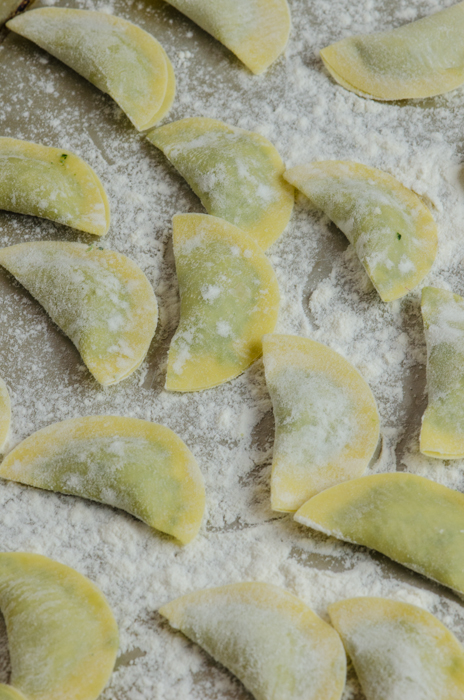 I adapted this recipe from a cookbook put out by the Sudtirol Tourism agency, Alpine Flavors: Authentic recipes from the Dolomites, the Heart of the Alps. Here, they introduced yet another name for this dish, the Ladin name Cajinci t’ega. The Ladin people are an unique ethnic group in northern Italy. Their native language is Ladin, a language related to the Swiss Romansh and Friulian languages. The Ladin people constitute only 4.5% of the population of South Tyrol, but their influence has played a role in the culture, history, and traditions of this region.
I adapted this recipe from a cookbook put out by the Sudtirol Tourism agency, Alpine Flavors: Authentic recipes from the Dolomites, the Heart of the Alps. Here, they introduced yet another name for this dish, the Ladin name Cajinci t’ega. The Ladin people are an unique ethnic group in northern Italy. Their native language is Ladin, a language related to the Swiss Romansh and Friulian languages. The Ladin people constitute only 4.5% of the population of South Tyrol, but their influence has played a role in the culture, history, and traditions of this region.
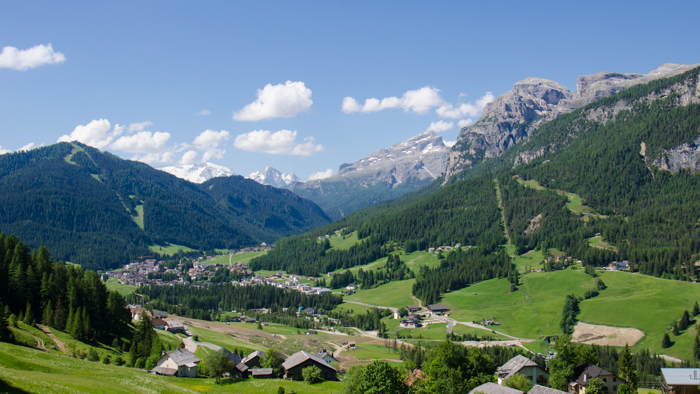
Cajinci t’ega – Mezzelune Pasta
Makes about 60 mezzelune
For the dough:
1 1/2 cups wheat flour
1 egg, plus 1 egg yolk
pinch of salt
2 tablespoons water
2 tablespoons milk
For the filling:
1/2 onion, finely chopped
1 Tablespoon butter
4 ounces of cooked, pureed spinach
3 ounces of ricotta cheese
To serve:
grated Parmigiano Reggiano
melted butter
finely chopped chives
How to make the dough:
Place the flour on your counter in a mound. Make a well in the middle. Add the eggs, water, milk and salt. Using a fork, lightly beat the eggs. Gradually start incorporating the flour from the sides of the well. Eventually the sides of the well will collapse, at this point use a pastry scraper to work the rest of the flour into the dough.
Knead the dough for about 15 minutes, working a bit more flour into it when it gets a bit sticky. The dough should be very smooth, silky, and very elastic.
To roll out the pasta using a pasta machine, divide the dough into 4 – 6 pieces. You will roll out one piece at a time, while rolling keep the remainder covered with plastic wrap so it does not dry out. Lightly flour the machine rollers, the work surface around the machine, and the first piece of dough. Set the rollers at the widest setting. Flatten the dough into a disc, sprinkle with flour, then feed the disc into the space between the two rollers. Feed the dough through with one hand, while holding the upturned palm of your hand under the sheet emerging from the rollers. Keep your palm flat to protect the dough from punctures by your fingers.
As the sheet emerges from the rollers, guide it away from the machine with your palm. Pass the dough through the rollers five to six times, folding it into thirds and flouring it each time. Then set the rollers at the next narrower setting and pass the dough through three times, folding it in half each time. Repeat, passing it through three times at each successively narrower setting. Repeated stretching and thinning builds up elasticity making especially light pasta. If the sheet becomes too long to handle comfortably, cut it in half or thirds and work the pieces in tandem.
Don’t worry if at first the dough tears, has holes, is lumpy, or is very moist. Just lightly flour it by pulling the dough over the floured work surface. Take care not to overdo the flouring, or the dough may get too stiff. As you keep putting it through the rollers, it will be transformed from slightly lumpy and possibly torn to a smooth, satiny sheet with fine elasticity.
Different machines have different numbers of settings. These ravioli use the thinnest setting on a machine, which will be thin enough for you to see color and shape through it; this is perfect for lasagne and filled pastas. If it is so thin that the dough tears easily, however, stop at the next to last setting.
Place the pasta sheets on a floured sheet pan, separated by deli paper or plastic wrap. Cover the pile with a slightly damp towel.
How to make the filling:
Saute the onion in a skillet with the butter. Place the onion, spinach, ricotta, and salt in a food processor. Pulse to mix thoroughly.
Preparation:
Cut discs of pasta from the prepared pasta sheets using a round cutter about 2 inches in diameter.
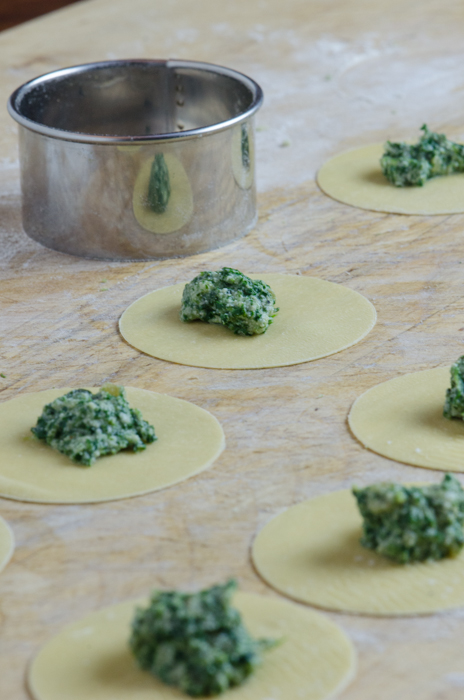 On half of each disc place a teaspoon of filling, fold over the other half and press the edges together well.
On half of each disc place a teaspoon of filling, fold over the other half and press the edges together well.
Cook the cajinci t’ega in boiling salted water.
Remove with a skimmer and drain, then dress with the melted butter and sprinkle with grated Parmigiano and finely chopped chives.
